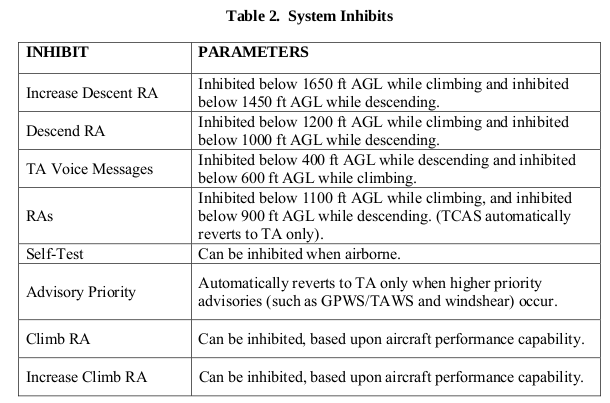The TCAS warning says: " DESCEND, DESCEND" and immediately after the crew receives: "TERRAIN, TERRAIN", what would they do?
-
8$\begingroup$ Best guess: they would panic $\endgroup$– kevinCommented Nov 19, 2015 at 13:12
-
4$\begingroup$ I would prefer to take on the other aircraft rather than the terrrain, but that's just me. $\endgroup$– Tyler DurdenCommented Nov 19, 2015 at 18:11
-
$\begingroup$ Flip around, then nose 'down', like proven in a recent movie $\endgroup$– xcy7eCommented May 24, 2020 at 20:47
2 Answers
TCAS (II) does not give the descend RA below 1200 ft AGL while climbing or below 1000 ft AGL while descending.
Image from FAA Advisory Circular 20-151A Table 2
In case such an unlikely event happens (and is not an equipment malfunction), the best possible maneuver is to climb away from the incoming aircraft i.e. turn and climb to the side of the previous route.
-
1$\begingroup$ EGPWS has a "look ahead" feature so can give a terrain warning even if you are not within 1200' AGL.... $\endgroup$ Commented Nov 19, 2015 at 16:16
-
$\begingroup$ @Lnafziger, the table implies that it should switch to TA ("TRAFFIC, TRAFFIC") in that case. $\endgroup$ Commented Nov 20, 2015 at 14:57
I would pull up and once in a stable climbs I would turn in either direction in this situation. If I get a warning to descend it is to prevent a conflict with another aircraft, whereas a terrain warning is to prevent impact with the ground. The ground is much bigger than another airplane, so the lower risk is collision with an aircraft. In other words, if I descend I will certainly hit the ground, if I climb I may hit another aircraft, so climbing wins. Turning in either direction will hopefully decrease the collision risk.
It would suspect this is an unlikely situation, TCAS should not give an instruction which would put you into another conflict.
-
$\begingroup$ Wouldn't turning increase the probability of crashing with the ground and/or the aircraft? $\endgroup$– TomCommented Nov 19, 2015 at 15:20
-
$\begingroup$ If the aircraft is climbing then contact with the ground shouldn't be a concern if turning. If you fly straight ahead then you will potentially be putting the aircraft into conflict again, so while turning could potentially increase the possibility of collision it has a greater chance of decreasing it. $\endgroup$– GdDCommented Nov 19, 2015 at 15:38
-
$\begingroup$ Makes sense. Also wouldn't it be better to instruct the aircraft above to ascend? what is the likelihood of this ever occurring? $\endgroup$– TomCommented Nov 19, 2015 at 15:41
-
$\begingroup$ This scenario is pretty unlikely as I don't think TCAS would say to descend if it was going to cause a terrain warning. As for communicating, that's actually a bad idea as it could cause confusion. See the Underlingen disaster as an example of that. $\endgroup$– GdDCommented Nov 19, 2015 at 16:35
-
4$\begingroup$ @GdD
If the aircraft is climbing then contact with the ground shouldn't be a concern if turning.<-- Depends on the terrain. For example if you got a GPWS alert in a canyon because the floor is rising making a turn (even in a climb) could cause you to impact the canyon wall. I'd wager the climb and the chance of hitting another aircraft would still be preferable to a descent and the certainty of hitting terrain though: You've got a better chance with Big Sky than you do with Big Dirt. $\endgroup$– voretaq7Commented Nov 19, 2015 at 18:52

